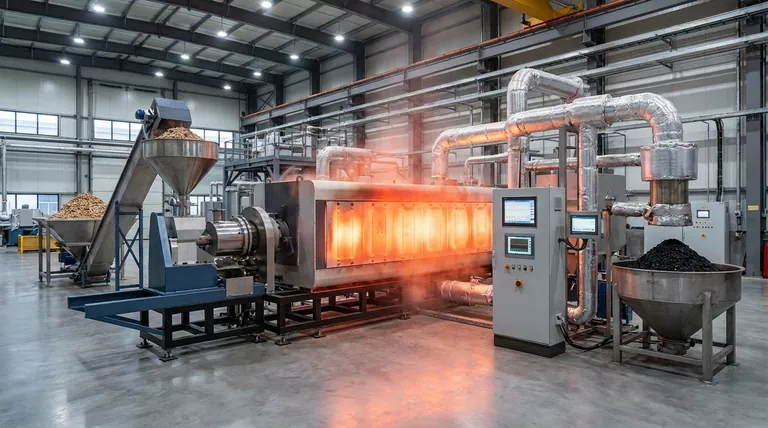At its core, pyrolysis is the thermal decomposition of materials at elevated temperatures in a closed system. It fundamentally depends on an external heat supply to drive the reaction, and its efficiency is dictated by the type of reactor used and the characteristics of the biomass feedstock, such as its moisture content.
The operational conditions of pyrolysis are not a single set of parameters but a dynamic interplay between the reactor's design, which controls how heat is applied, and the properties of the material being processed.

The Fundamental Principle: Controlled Decomposition
Pyrolysis is a carefully controlled process. Unlike combustion, the goal is to break down material using heat alone, without allowing it to burn.
A Closed, Oxygen-Free System
Pyrolysis reactors operate as closed systems. This is critical to prevent oxygen from entering, as its presence would lead to combustion (burning) rather than the desired thermal decomposition.
The Role of External Heat
Heat is the primary driver of the reaction. An external source heats the reactor, and this thermal energy is transferred to the biomass, causing its complex molecules to break apart into simpler, more valuable products like bio-oil, syngas, and biochar.
How Reactor Design Dictates Conditions
The method of heat transfer is the most significant operational variable, and it is determined entirely by the reactor's design.
The Fixed-Bed Reactor
In a fixed-bed reactor, the biomass particles are stationary. Heat is applied to the walls of the vessel and slowly diffuses inward through the packed material.
This design results in a relatively slow and steady rate of decomposition, as heat must gradually penetrate the substrate.
The Ablative Reactor
An ablative reactor uses a completely different principle. It is a pressure-driven system that forces the biomass directly against a very hot surface.
This intense, direct contact causes the material to rapidly "melt" and decompose, leaving a film of oil that lubricates subsequent particles. This method facilitates extremely rapid heat transfer.
Optimizing the Biomass Feedstock
The efficiency of any pyrolysis system also depends heavily on the input material. Simply applying heat is not enough; the feedstock must be properly prepared.
Biomass Suitability
Different types of biomass react differently to heat. Selecting a feedstock that is well-suited for the specific reaction and desired output products is a crucial first step.
Managing Moisture Content
Proper moisture content is essential for an efficient process. If the biomass is too wet, a significant amount of energy will be wasted simply boiling off water instead of breaking down the material itself.
Understanding the Trade-offs
The choice of operational conditions involves balancing competing factors. There is no single "best" method; the optimal choice depends on the specific goal.
Speed vs. Simplicity
The ablative reactor offers very high processing speeds due to its rapid heat transfer. However, its mechanical complexity is higher.
The fixed-bed reactor is mechanically much simpler but operates at a significantly slower rate because heat transfer is less efficient.
Heat Transfer as the Core Variable
Ultimately, the central operational condition is the rate and efficiency of heat transfer. Fixed-bed reactors rely on slow diffusion, while ablative reactors use direct, high-pressure contact to maximize this rate.
Matching Conditions to Your Goal
To select the right operational approach, you must first define your primary objective.
- If your primary focus is simplicity and controlled decomposition: A fixed-bed reactor's straightforward design and slower, more predictable heating rate is the most suitable choice.
- If your primary focus is high throughput and rapid processing: An ablative reactor is superior, as its pressure-driven, direct-contact heating method is designed for speed.
Mastering the conditions of pyrolysis means controlling the flow of heat to achieve your specific chemical conversion goal.
Summary Table:
| Operational Condition | Key Factor | Impact on Process |
|---|---|---|
| Reactor Type | Heat Transfer Method | Dictates speed and efficiency of decomposition |
| Biomass Feedstock | Moisture Content & Suitability | Affects energy efficiency and product yield |
| System Environment | Closed, Oxygen-Free | Prevents combustion, enabling controlled decomposition |
Ready to optimize your pyrolysis process? KINTEK specializes in laboratory equipment and consumables for advanced thermal processing. Whether you need a simple fixed-bed reactor for controlled decomposition or a high-throughput ablative system, our expertise ensures you get the right equipment for your specific biomass and goals. Contact our experts today to discuss how we can support your lab's pyrolysis research and development.
Visual Guide

Related Products
- Electric Rotary Kiln Small Rotary Furnace Biomass Pyrolysis Plant
- Electric Rotary Kiln Pyrolysis Furnace Plant Machine Calciner Small Rotary Kiln Rotating Furnace
- Electric Rotary Kiln Continuous Working Small Rotary Furnace Heating Pyrolysis Plant
- Vacuum Sealed Continuous Working Rotary Tube Furnace Rotating Tube Furnace
- Electric Rotary Kiln Small Rotary Furnace for Activated Carbon Regeneration
People Also Ask
- What are the products of pyrolysis of biomass? Unlock Bio-Char, Bio-Oil, and Syngas
- What are the reactions involved in pyrolysis of biomass? Unlock the Chemistry for Tailored Bio-Products
- What are the different types of pyrolysis machines? Choose the Right System for Your Output
- What are the conditions for biomass pyrolysis? Optimize Temperature, Heating Rate & Time
- What are the components of biomass pyrolysis? A Complete Guide to the System, Products, and Process



















